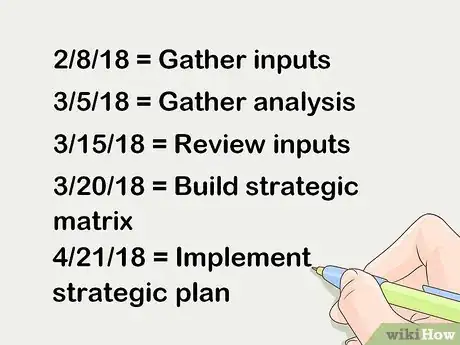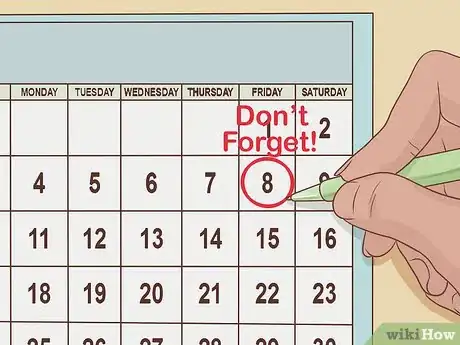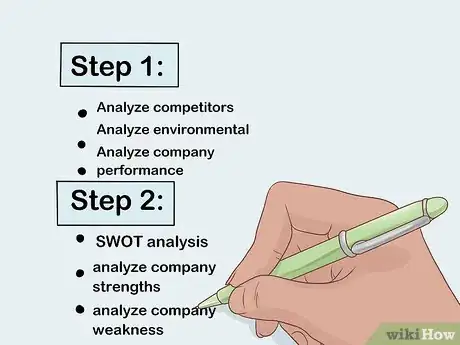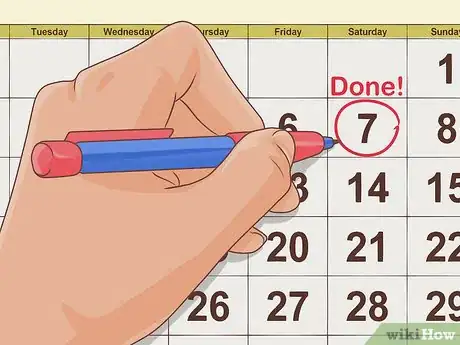X
wikiHow is a “wiki,” similar to Wikipedia, which means that many of our articles are co-written by multiple authors. To create this article, volunteer authors worked to edit and improve it over time.
This article has been viewed 34,520 times.
Learn more...
A strategy is a well-designed plan of attack for a personal or professional goal. The success of a strategy depends upon how realistic it is, how detailed it is and how organized the action steps are. Create your strategic planning team, organize five to 10 action steps and set up review deadlines to strategize effectively.
Steps
Part 1
Part 1 of 4:
Choosing an Issue to Address
-
1Start with an issue you want to address. This is your starting point.
-
2Strategize one issue at a time. If you have several issues that need to be addressed, you will need several strategies. Strategy is a custom process, not a one-size-fits-all solution.Advertisement
-
3Pick a goal or desired outcome. Choose the scope of what you want to achieve. You have created your ending point, and the strategy will fill out all your actions from start to end.
-
4Decide whether the goal is feasible. Perhaps you want to ask others with more experience if they think it can be done. For example, if you want to get a promotion in one year, ask a colleague in a higher position how long it took them to get into a management role.[1]
- If the goal is not a feasible one, try to go for a more feasible solution, such as getting a 5 percent raise or more responsibility. Later, strategize how to get a promotion in two or five years.
Advertisement
Part 2
Part 2 of 4:
Making a Planning Team
-
1Invite others to join your strategic planning session that have a stake in the outcome. At work this may be all the members of management or a department. For personal goals, this may be your partner, parents or friends.[2]
-
2Explain the goal to your team. Give them a period time to think about the issues.
-
3Specialize. If someone is a human resources representative, they should strategize how best to ask for a raise. If someone else is a financial planning expert, they can strategize how the raise could improve your quality of life and motivation.
-
4Brainstorm some ideas about how to address the issue. Write any potentially useful ideas.[3]
Advertisement
Part 3
Part 3 of 4:
Picking Your Tools
-
1Get organized. The most important tools are a pen and pencil while you bring up ideas. However, other tools can help you collect information along the way and chart progress.
-
2Decide how you will keep track of your process. You will need to quantify your success on a weekly or monthly basis.
- For example, if you want to gain 500 more Facebook followers, you should report on the number of total and new followers each month, in addition to the posts you have used. Facebook itself has several valuable reporting tools.
-
3Get high tech. At the very least, you should have an Excel spreadsheet, but you may also want to sign up for a Google Analytics account, a CRM management software or a financial tracker like Mint.com.
Advertisement
Part 4
Part 4 of 4:
Setting Goals and Timelines
-
1Decide when your final deadline to achieve a strategy will be.
-
2Break down the strategy into 5 to 10 action steps between now and the final deadline. Date those steps to indicate when they should be put into motion.
-
3Mark those dates in your calendar, with extra reminders for projects that will take several weeks to complete.
-
4Break each step into sub-steps if necessary. Organize them into bulleted points with as much information as necessary.
-
5Delegate tasks to others if it is a team strategy. Make them accountable to you or other people, by asking them to submit a progress report on a specific day.
-
6Review the data every month. Adjust your steps accordingly to account for adjustments in deadline or approach.
-
7Share all strategy plans with people who are involved with the strategy. Update the documents and share them whenever they change.
- Consider starting a Google Drive spreadsheet or document if you don’t have a common platform to use with other people in the strategic planning committee.
-
8Make a date for the strategy to be complete. Review it at that time. If it has been successful, consider using similar strategies in the future.
- If it hasn’t been successful, learn from your mistakes and try new steps each time.
Advertisement
References
About This Article
Advertisement













































































